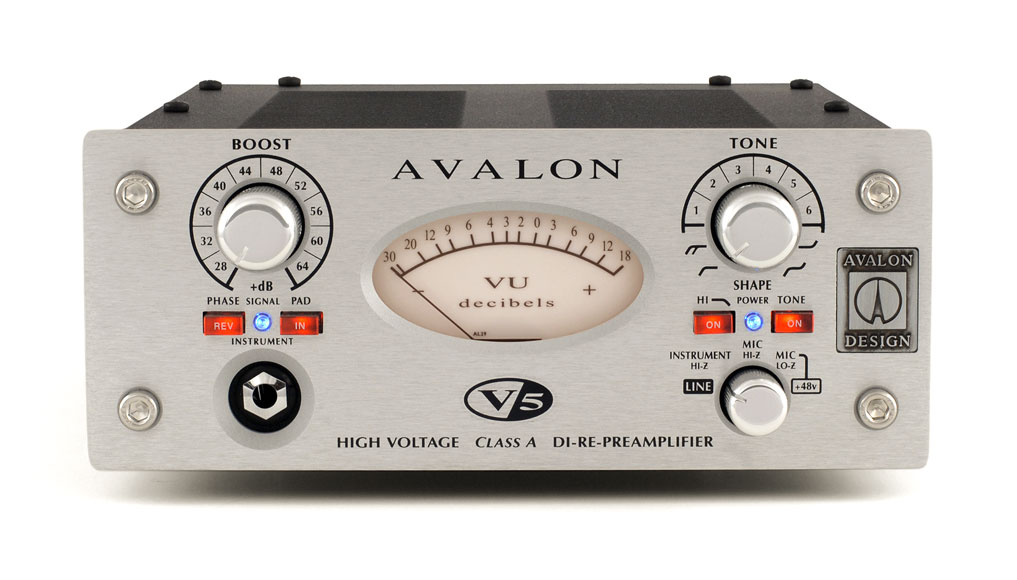
| REVIEWS: | |
|
AVALON DESIGN V5
By Paul Vnuk Jr. Avalon Design V5 Pure Class A DI-RE-Preamplifier
Touring the V5 Connections and specs Mic it Despite using Avalon equalizers and compressors in friends' mastering studios over the years, this is the first time I've had a piece of Avalon gear in my studio. I was very glad to connect with the Avalon team at last June's Sweetwater GearFest... and even more glad once I got to put the V5 to work. The microphone preamp on the V5 is impressive. The first words that come to mind with the V5's mic pre are "clean" and "powerful". This is definitely in the "straight wire with gain" camp-the V5's high voltage rails give it an extremely clear and open sound with headroom for days. Its transformerless output keeps the lows full and deep. I love that it has impedance options for high- and low- impedance mics. What really impressed me was how the V5 handled old standbys like the Shure SM-7B, a favorite of mine but a relatively low-gain dynamic mic. The V5 gave me some of the cleanest and punchiest sounds I have ever heard from the SM-7B on voiceover work (without using a Cloud Microphones Cloudlifter or similar impedance adjustment device). It's equally clean and nice-sounding with even the finickiest passive ribbon mics in my closet. Direct it Similarly, direct signals captured by the V5 are solid and clean; the V5 like its cousin the U5, is an absolute wonder on DI bass and electric guitars. Its instrument input offers +36dB of headroom before overloading, and its exceptional sound is due in part to the fact that it uses very high input impedance (a whopping 10Meg-Ohm), which places effectively no load on pickups. Piezo-equipped guitars will love the V5! Tone it The first six settings-the TONE-BANK™ settings from the U5-are tailed to be source-specific. Both settings 2 and 3 are wonderful for direct tracking of bass, and while setting 4 is suggested for acoustics, strings, electric and bass guitars, and keyboards, I loved it on vocals with the abovementioned SM-7B! The other four settings are made to be more microphone-focused. They include two different highpass filter curves, one of which is also available with something called Air-Lift, a gentle high-end boost that I found especially nice on darker ribbon mics. Reamplify it Reamplification with the V5 is very simple. Start by tracking your guitar, bass, or even your keyboard through the V5 to your DAW. The Thru lets you track clean while letting the talent hear an amp to inspire their playing, and I found the direct input to be clean and powerful enough to do a beautiful job tracking low-output electric pianos like my Fender Rhodes. Then send that signal out of your DAW to the V5's line input, and the -18dB 1/4" out is sent to your amp at the appropiate input impedance level. Mic up your amp and you're good to go! I recently used the V5 for a bass tracking session where we tracked a Fender Jazz Bass direct through Tone setting 3 and then re-amped that out to a 1959 Fender Bassman miked with a Neumann U47 fet. The bass player who often works at my studio felt that when the two signals, direct with Tone 3 plus miked with the Neumann, were combined, it was the hands down the best bass sound he had ever gotten at my studio. Conclusions It's hard not to be impressed by this box, especially because it does so many things and does them all exceptionally well. The V5 can be equally at home in a high-profile pro studio, or as a great single centerpiece for a home or project studio, tacklying your mic and instrument tracking needs with ease. The Avalon V5 is not inexpensive, but its price is certainly not out of line considering all it does. This is one great sounding, beautiful looking, and impeccably built and designed piece of gear, and a worthy sibling to the U5 and M5 in the Avalon family. Click to View Original Article Back to Reviews Index & User List |
Tel: +1 949 492 2000
©2023 Avalon Design USA LLC
